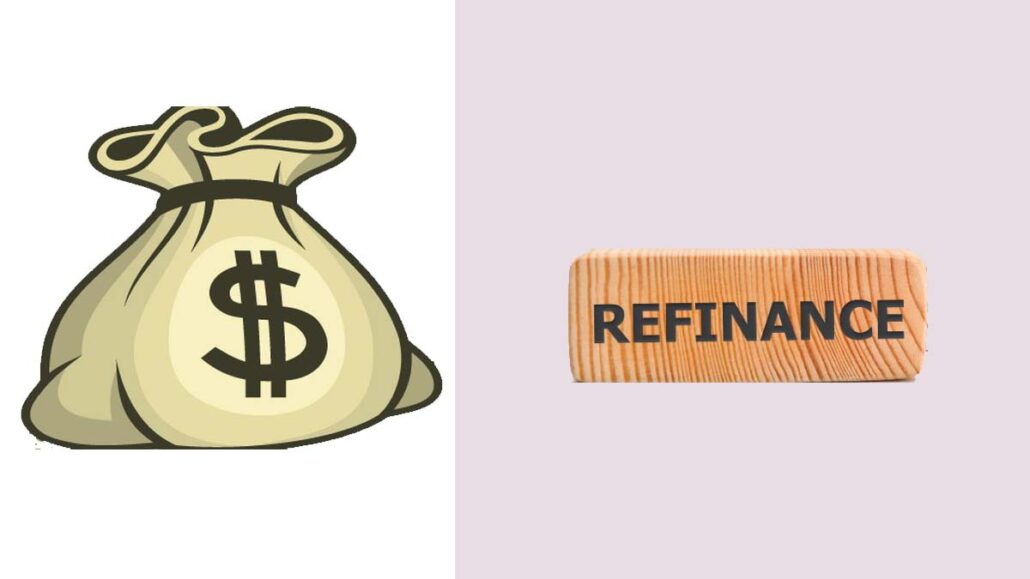Feeling strapped for cash but hesitant to sell your home? You might be surprised to learn that your home holds a hidden asset: equity. This equity, the difference between your home’s value and what you owe on your mortgage, can be unlocked through a financial strategy known as cash out refinance.

In simple terms, a cash-out refinance replaces your existing mortgage with a new, larger loan. The difference between these two amounts is paid to you in cash, providing a lump sum you can use for various purposes like home renovations, debt consolidation, or even educational expenses. It’s essentially leveraging the value you’ve built in your home to access immediate cash without selling. But before diving in, it’s crucial to understand the implications and weigh the pros and cons to ensure a cash-out refinance aligns with your financial goals.
So, whether you’re dreaming of a kitchen remodel or need a financial boost, stay tuned as we delve deeper into the world of cash-out refinancing. We’ll explore how it works, its potential benefits and drawbacks, and when it might be the right option for you.
What is a Cash-Out Refinance?
Simply put, a cash out refinance replaces your current mortgage with a new, larger loan. The difference between the two amounts is paid to you in cash, which you can use for various purposes like:
- Debt Consolidation: Lower your interest rates and streamline your payments by consolidating high-interest debt with your mortgage.
- Home Improvements: Upgrade your kitchen, bathroom, or other areas, adding value and enjoyment to your home.
- Major Expenses: Cover unexpected costs like medical bills or educational fees without dipping into savings or taking out high-interest loans.
- Investments: Fuel your financial future by investing in real estate, stocks, or other assets.
Benefits of a Cash-Out Refinance
Lower Interest Rates
Interest rates fluctuate, and if yours have climbed since buying your home, a cash-out refinance can snag you a significantly lower rate. This translates to potential savings over the life of your loan, freeing up more money for your dreams.
Consolidate Debt
Struggling with high-interest credit cards or personal loans? A cash-out refinance can offer a lower interest rate, consolidating your debts into a single, manageable monthly payment. This simplifies your finances and potentially saves you thousands in interest charges.
Invest in Your Home
Dream of a kitchen remodel or a sparkling new bathroom? A cash-out refinance can provide the funds to upgrade your living space, increasing its value and enjoyment. Additionally, interest on home improvement loans may be tax-deductible, offering another sweet perk.
Boost Your Financial Security
Facing unexpected expenses or need a safety net? Accessing your home’s equity can provide a financial cushion, offering peace of mind and the ability to weather life’s storms with confidence.
Flexibility and Freedom
Unlike targeted home equity loans, a cash-out refinance gives you the freedom to use the funds for virtually any purpose. Whether it’s funding education, starting a business, or taking that dream vacation, the choice is yours.
Is a Cash-Out Refinance Right for You?
It depends! Consider these factors:
- Equity: You’ll typically need at least 20-25% equity in your home to qualify.
- Credit Score: A good credit score (usually 670+) ensures favorable interest rates.
- Debt-to-Income Ratio: A DTI ratio below 36% indicates your ability to handle additional debt.
- Financial Goals: Ensure the cash aligns with your long-term financial objectives.
- Risk Tolerance: Understand that you’ll be increasing your overall mortgage debt.
Pros and Cons
While a cash-out refinance can be a tempting option, it’s crucial to understand both the pros and cons before making a decision:
Pros:
- Access lump sum cash: This is the key benefit, allowing you to tackle larger expenses like home improvements, debt consolidation, or even educational costs.
- Potentially lower interest rate: If current rates are lower than your existing mortgage, you could snag a better deal and save money over time.
- Consolidate high-interest debt: Rolling credit card debt or other high-interest loans into your mortgage can simplify repayment and potentially save on interest charges.
- Increase home value: Strategic renovations funded by the refinance can boost your property’s value, potentially recouping the loan amount in the future.
Cons:
- Increased debt and risk: You’ll be borrowing more money, extending your loan term, and potentially increasing your monthly payment, which could strain your budget.
- Higher interest rate than standard refinance: Cash-out refinance often comes with slightly higher rates due to the increased risk for the lender.
- Loss of mortgage interest tax deduction: The interest on your new loan might not be tax-deductible, impacting your overall tax benefits.
- The temptation for misuse: The readily available cash could lead to impulsive spending, negating the financial benefits.
- Foreclosure risk: As with any mortgage, defaulting on payments puts your home at risk of foreclosure.
Ultimately, the decision depends on your circumstances and financial goals. Carefully consider your needs, weigh the pros and cons, and consult a financial advisor for personalized guidance before proceeding with a cash-out refinance. Remember, it’s a powerful tool, but one that requires responsible use.
Eligibility Requirements and Qualification
Lenders establish specific eligibility requirements and qualification factors to assess your suitability and manage their risk. Here’s a breakdown of the key hurdles you’ll need to clear:
Eligibility Requirements:
- Minimum home equity: This varies depending on the loan type, but typically ranges from 20-60%. It ensures you have sufficient “skin in the game” to protect the lender.
- Credit score: Aim for a score of at least 620 (though higher is better), demonstrating your responsible credit history.
- Debt-to-income ratio (DTI): This measures your monthly debt obligations compared to your income. Lenders typically prefer a DTI below 43%, indicating your ability to handle additional debt.
- Employment stability: Consistent and verifiable employment history strengthens your application.
- Property type: Not all property types qualify for cash-out refinancing. Check with lenders for eligible property types.
Qualification Factors:
- Home appraisal: A professional appraisal determines your home’s current market value, influencing the maximum loan amount you can access.
- Loan terms: Choose a loan term that aligns with your budget and repayment goals, considering the impact on your monthly payment.
- Interest rate: Negotiate for the best rate possible based on your financial profile and market conditions.
- Closing costs: Understand and factor in all associated closing costs to avoid surprises.
Remember, these are general guidelines, and specific requirements may differ depending on the lender and loan program. Consult a qualified mortgage professional to assess your eligibility and navigate the qualification process smoothly.
Cash out Refinance Tax Implications
Understanding the tax implications of a cash-out refinance is crucial before making any decisions. Here’s a breakdown of the key points:
- General Principle: Cash Received Is Not Taxable: The money you receive from a cash-out refinance is generally not considered taxable income. This is because the IRS views it as a loan against your home’s equity, not as earned income.
- Interest Deductions: Where Tax Implications Arise: The primary tax implications relate to the deductibility of the interest you pay on the new, larger mortgage. Home Improvements:
- If you use the cash-out funds to “buy, build, or substantially improve” your primary or second home, you may be able to deduct the interest paid on that portion of the loan.
- “Substantial improvements” generally refer to projects that increase your home’s value, extend its lifespan, or adapt it to new uses. Examples include additions, renovations, and major system replacements.
- Routine repairs and maintenance typically do not qualify.
- Limitations:
- There are limits to how much mortgage interest you can deduct.
- It is very important to keep accurate records of how the cash out funds are spent.
- Non Qualifying expenses:
- If you use the funds for things like paying off credit card debt, vacations, or other personal expenses, the interest paid on that portion of the loan is typically not deductible.
Steps involved in the cash-out refinance process
The process of securing a cash-out refinance can seem daunting, but with a clear roadmap, it becomes more manageable. Here’s a breakdown of the key steps involved:
1. Research and Planning:
- Assess your needs: Determine the amount of cash you require and how you plan to use it.
- Shop around: Compare rates and terms from multiple lenders to find the best deal.
- Understand eligibility: Familiarize yourself with the eligibility requirements and qualification factors discussed earlier.
- Gather documents: Prepare necessary documents like pay stubs, tax returns, and bank statements.
2. Application and Approval:
- Submit your application: Choose a lender and complete the application, providing all required documents.
- Home appraisal: A professional appraiser will assess your home’s value to determine the maximum loan amount.
- Underwriting: The lender will verify your financial information and creditworthiness to approve your application.
3. Closing and Disbursement:
- Review closing documents: Carefully review all loan terms, fees, and disclosures before signing.
- Closing day: Attend the closing to finalize paperwork and receive your loan proceeds, minus closing costs.
- Disbursement: The lender will pay off your existing mortgage and provide you with the remaining cash.
Remember, this is a simplified overview, and specific steps may vary depending on the lender and your circumstances. By understanding these key steps and consulting with qualified professionals, you can navigate the cash-out refinance process with confidence and unlock the potential of your home’s equity.
FAQ’s
How much equity do I need for a cash-out refinance?
Most lenders require you to maintain at least 20% equity in your home after the refinance. Some lenders may allow for less, but this is less common, and usually comes with higher interest rates.
What is the difference between a cash-out refinance and a home equity loan?
A cash-out refinance replaces your existing mortgage with a new, larger loan. A home equity loan is a second mortgage that allows you to borrow against your home’s equity while keeping your existing mortgage in place.
Are there tax implications for a cash-out refinance?
The cash you receive from a cash-out refinance is generally not considered taxable income. However, if you use the funds for home improvements, you may be able to deduct the interest paid on the loan. Consult with a tax professional for personalized advice.
How long does a cash-out refinance take?
The process typically takes 30 to 45 days, similar to a regular mortgage refinance.
Will a cash-out refinance affect my credit score?
Applying for a cash-out refinance can result in a temporary dip in your credit score due to the hard inquiry. However, making on-time payments on your new mortgage can positively impact your credit score over time.
Can I use a cash-out refinance to buy another property?
Yes, you can use the cash from a cash-out refinance to purchase another property. However, lenders will consider your debt-to-income ratio and overall financial stability.
What are the closing costs associated with a cash-out refinance?
Closing costs typically range from 2% to 5% of the new loan amount. These costs include appraisal fees, origination fees, title insurance, and other related expenses.
What is the maximum loan-to-value (LTV) ratio for a cash-out refinance?
Most lenders have a maximum LTV ratio of 80% for cash-out refinances. This means you can borrow up to 80% of your home’s appraised value.
Can I get a cash-out refinance if I have bad credit?
It may be more challenging to get approved for a cash-out refinance with bad credit. However, some lenders specialize in working with borrowers with less-than-perfect credit. Be prepared to pay higher interest rates and fees.
How do I find the best cash-out refinance rates?
Shop around and compare rates from multiple lenders. Get pre-approved to see what rates and terms you qualify for. Consider working with a mortgage broker who can help you find the best deals.

